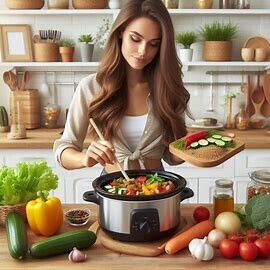
You might think kitchen gadgets are just about convenience, right? But your slow cooker is like a hidden gem when it comes to cooking up healthy meals, and it’s more than just about tossing ingredients and hoping for the best. Slow cooking can actually help lock in all those precious nutrients we need, instead of cooking the heck out of them.
One thing I love about slow cookers is how they help us steer clear of the not-so-healthy stuff. With slow cooking, you have way more control over what ends up in your meals. You can keep things on the healthy side by choosing lean meats and throwing in as many veggies as your heart desires. And let’s not forget seasoning – a slow cooker lets you go easy on the salt and butter because it’s all about those herbs and spices bringing the flavor.
There are always all sorts of hearsay when it comes to cooking tactics, and slow cooking has its share of myths floating around. Some folks think that leaving food to cook slowly might make it unsafe or that it somehow drains out the nutrients. Spoiler alert: that’s not true! The slower, lower heat can actually help retain more vitamins and minerals than other cooking methods that expose food to high temperatures.
So next time you’re loading up that pot, feel good knowing it’s not just about comfort but also about health. And here’s my friendly tip – keep experimenting with different whole foods and spices. The slow cooker’s magic lies in how it makes healthy ingredients shine without much fuss.
Harnessing The Full Potential Of Your Slow Cooker

Slow cookers are the ultimate time-saver in the kitchen, but getting the hang of them can be a learning curve. The key to mastering it is to get the basics right, which means starting with how you fill that pot. A good rule of thumb? Keep it about half to two-thirds full. Overfilling can mess with cooking times, while not enough food might lead to overcooked disasters.
Timing is everything. A common mistake is thinking your slow cooker is a one-size-fits-all gadget when it comes to cooking times. It’s crucial to follow recipe timings or adjust accordingly if you’re experimenting. Cooking on ‘low’ takes longer but enhances flavors in ways that ‘high’ won’t.
And about those ingredients – yes, they matter! Start layering them properly, with sturdier veggies like carrots and potatoes at the bottom since they take longer to cook. Meats and softer veggies should be in the middle or top for even cooking.
Believe me, one of the best practices is prepping everything the night before. Get all your chopping and measuring out of the way, and store it in the fridge. Next morning, all you need to do is set, forget, and go about your day without a hitch. It’s a stress buster!
Remember, every mistake is just a stepping stone to slow-cooking glory. So, experiment, adjust, and tweak until you get to that sweet spot. Learning the quirks of your slow cooker might take a few tries, but once you do, you’ll wonder how you ever lived without it.
Troubleshooting Common Slow Cooker Issues
Got a watery meal every time you lift that lid? It’s like an unsolved mystery! Slow cookers work by trapping the steam, which often means more liquid at the end of cooking than you started with. It’s a common hiccup with slow cooking, but it’s totally fixable.
One quick fix is to thicken up with ingredients you probably already have on hand. Flour or cornstarch can work wonders. Stir a tablespoon with a bit of cold water until smooth, then mix it into your dish about 30 minutes before you’re ready to pull the plug.
Choosing the right ingredient balance can also help. Some veggies naturally release more water while cooking, so cutting back on added liquids when using water-rich foods like tomatoes or mushrooms prevents a soupy outcome. Just be mindful of your mix and match for a thicker consistency.
Another top trick is removing the lid at the end of cooking to let some of that steam escape. If your meal has cooked fully, turning the heat to high mode with the lid off can reduce extra liquid fast without overcooking. You’ll be amazed at how much that changes the dish!
Each meal offers a chance to fine-tune your approach and get those perfect results. So next time, watch out for the liquid, apply some of these tips, and you’ll wave goodbye to watery woes in no time!
Creative Cooking With Confidence: Elevate Your Slow Cooker Dishes
Slow cookers aren’t just for chili or stew. They’re your secret weapon for crafting all sorts of world cuisines without breaking a sweat. With a bit of creativity, you can whip up dishes that are as exciting as they are nutritious.
Ever thought about meal prepping for the week using a slow cooker? It’s honestly a game-changer, especially if you’re juggling a busy schedule. You can prepare everything on Sunday, let the cooker do its magic, and enjoy the benefits throughout the week. Curries, soups, and even oatmeal can be prepped ahead, saving you heaps of time.
The beauty of a slow cooker is its versatility. You can dive into making zesty Mediterranean dishes, spicy Mexican fare, or comforting Asian recipes—all with the same appliance. It’s about embracing different ingredients and spices, which can transform your kitchen into a culinary frontier.
Even dietary needs like vegan, gluten-free, or high-protein can benefit from slow cooking. It’s all about picking the right ingredients and recipes. The Internet is brimming with options to suit just about every diet and palate. So why not try a chickpea curry or a quinoa-based veggie stew for a healthy twist?
You’re not just cooking; you’re creating meals that fit your life and taste buds. As you get comfortable experimenting, you’ll find your confidence growing—making meals you love, and that love you right back. Each slow-cooked meal might just inspire the next!





I was gifted a slow cooker about a year ago, and is the best gift I have received in many years. It has become my go-to method of cooking if we are going to have guests around. I can do all my preparation in advance, get the slow cooker going, and basically forget about it for the rest of the day.
I have learnt now to not add too many liquids, as a lot of the natural juices will be retained while cooking. My favourite way of using the excess liquid, is to cook the rice in the liquid, or even couscous. I just pour off the amount that I require, and it forms a fantastic stock.
Even saving the extra liquid for soup stock, is a great way of still getting all the nutrients, as well as the yummy taste.
I know what you mean, and I just love the smell that permeates the house all day long.